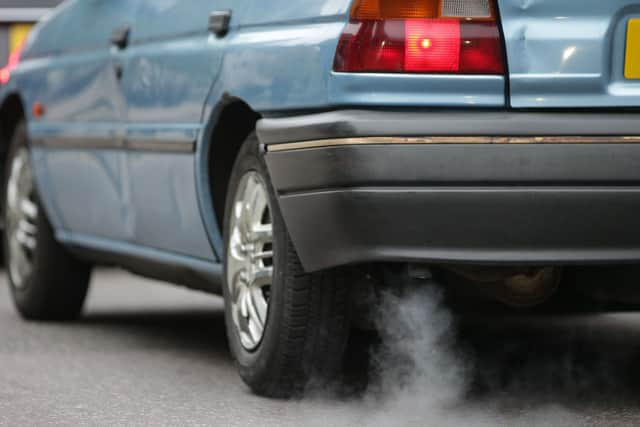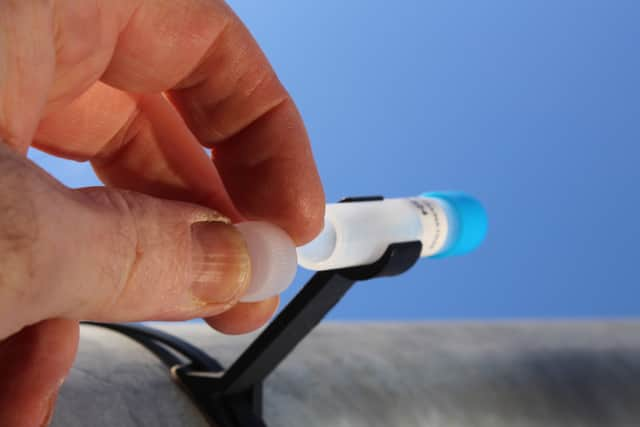Air pollution: levels above global health guidelines at Greater Manchester monitoring sites
and live on Freeview channel 276
Air pollution levels at monitoring sites across Greater Manchester were higher than a global health guideline last year, data shows.
Exclusive analysis of pollution measurements by the NationalWorld data team show levels of the fine particulate matter PM2.5 were above the latest level set down by the World Health Organisation (WHO) across the city-region and the country last year.
Advertisement
Hide AdAdvertisement
Hide AdOnly two out of 60 monitoring sites where the dangerous pollutant’s annual average level was calculated last year had a figure below the most recent WHO guideline.
The Government has said it is aiming to cut pollution levels but leading environmental organisations say a lot more needs to be done.
The concerning findings tally with analysis of air pollution readings previously done by ManchesterWorld, which found that in 2021 sites in the city centre were regularly breaching the WHO’s daily guideline for another common pollutant.


What did the data show for Greater Manchester?
The analysis measured the annual mean level of PM2.5 in micrograms per cubic metre at monitoring sites which are part of the Automatic Urban and Rural Network (AURN), one of a number of systems which measure air quality across the country.
Advertisement
Hide AdAdvertisement
Hide AdThe data is verified and published by the Department for the Environment, Food and Rural Affairs (Defra).
The UK legal limit for PM2.5 is an annual average of 20 micrograms per cubic metre, but the WHO sets out far more stringent guidelines.
Last year, it halved its guideline for PM2.5 from 10 to just five micrograms per cubic metre.
Out of 60 monitoring sites which provided sufficient data to analyse, only two across the UK had an annual average lower than the newest WHO guideline.
Advertisement
Hide AdAdvertisement
Hide AdIn Greater Manchester, the annual average for the Salford Eccles monitoring station was 8.86 micrograms per cubic metre, just above the level at Manchester Piccadilly which was 8.82 micrograms.
The monitoring station in Wigan recorded an average of 8.38 micrograms per cubic metre.
Pollution levels dropped in 2020 when the novel coronavirus hit and the figures for 2021 were still below those recorded pre-pandemic.
What is particulate air pollution?
Particulate matter is everything in the air that is not a gas. The tiniest particles, known as PM2.5, are particularly hazardous to health because they can pass through the lungs into the bloodstream, potentially damaging other organs.
Advertisement
Hide AdAdvertisement
Hide AdThese fine particles, far smaller than the width of a human hair, are known to cause asthma, chronic obstructive pulmonary disease and lung cancer.
They come mainly from traffic fumes, but also through industrial processes and wood and coal fires.
How dangerous is particulate air pollution?
Levels of disease caused by air pollution are on a par with those caused by smoking, according to the WHO.
It estimates that air pollution causes 4.2 million early deaths worldwide each year.
Advertisement
Hide AdAdvertisement
Hide AdUnveiling tougher new guidelines for pollutant levels last year, it said there was “now a much stronger body of evidence to show how air pollution affects different aspects of health at even lower concentrations than previously understood”.
Particulate air pollution contributed to one in every 18 deaths of over-30s in England in 2020, according to Government estimates.
However, this estimate could be affected by the fact that pollution levels dipped in 2020 due to the restrictions brought in to combat Covid-19.
What has been said about the PM2.5 levels?
Defra said it aimed to cut people’s exposure to particulate pollution by more than a third by 2040, compared with 2018 levels.
Advertisement
Hide AdAdvertisement
Hide AdA spokesperson said this would make a significant contribution to public health, resulting in up to 214,000 fewer cases of cardiovascular disease, 56,000 fewer strokes, 70,000 fewer cases of asthma and 23,000 fewer cases of lung cancer over the course of 18 years.
But Friends of the Earth called for more to be done and faster.
Its air pollution campaigner, Jenny Bates, said: “For far too long too little has been done to protect people from the scourge of air pollution, which particularly affects the young, the elderly and the most disadvantaged.
“Particular action is needed to cut levels of the most health damaging fine particles, which can get deep into the lungs and bloodstream and can lead to disease and early death.
Advertisement
Hide AdAdvertisement
Hide Ad“The new Prime Minister must go further and quicker to reduce pollution from PM2.5. The planned target should be brought forward to 2030, with tougher World Health Organisation levels achieved shortly after.
“Road building plans must be scrapped and more must be done to reduce traffic because particulate pollution also comes from braking and tyre wear – and not just exhausts.
“More must also be done to encourage people to use alternatives to driving with cheap and convenient public transport and investment in better and safer facilities for cyclists and pedestrians.”
Air pollution a major topic in Greater Manchester
Advertisement
Hide AdAdvertisement
Hide AdManchesterWorld ran an analysis of 2021 levels of nitrogen dioxide (NO2) at four monitoring stations across Manchester and Salford.
We found there were dozens of breaches of the daily level set down by the WHO, with the NO2 level recorded by the Oxford Road monitoring station above the guideline virtually every day.


And statistics compiled by the Central Office of Public Interest (COPI) showed earlier in 2022 that more in one in four properties in Manchester are among the 10% most polluted addresses in the UK.
The authorities in Greater Manchester say they recognise air pollution as a major health issue contributing to deaths in the city-region each year.
Advertisement
Hide AdAdvertisement
Hide AdHowever, an attempt to bring in a Clean Air Zone (CAZ) for the city-region was greeted by an angry backlash from businesses and residents. A non-charging scheme is currently being worked up, but green and health campaigners have voiced concerns that this will not do enough to tackle the scale of the pollution problem.
